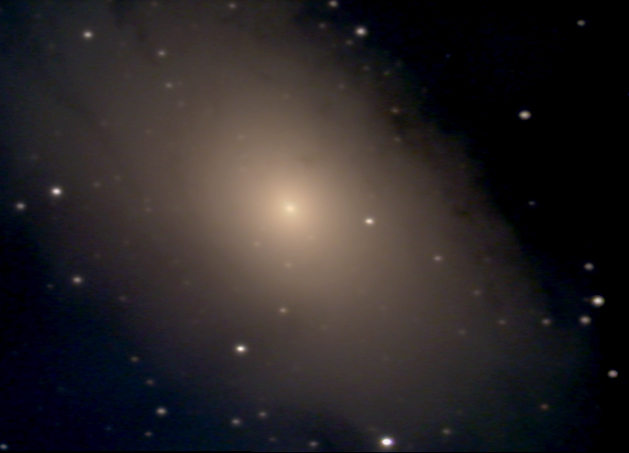
M31: Andromeda Galaxy

RA: 00hr 42min 42sec, Dec: 41º 16' 00", Mag: 3.5 Distance: 2.2 million light-years Constellation: Andromeda
If you saw the previous photo of M31 which I took, you will understand why I was in a hurry to have another go at it and replace it. Even this new one does not do our closest galactic neighbour justice, compared with professional photos taken from large observatories or even those taken by more accomplished amateurs than myself, especially those taken with SLR cameras, digital or film. This photo was taken on the 8th of September 2006 with the moon in its final quarter and therefore not rising until much later in the night. The temperature was 15.4°C and there was a fine mist in the air. The great technical difficulty of capturing M31 with the DSI is overcoming the dynamic range in brightness from the galactic core to the delicate nebulosity of its peripheries which is relatively dark, and of course, the narrow field of view of the DSI. In the picture above, the oblique sideways view of the galactic disc should extend from the top left of the frame, all the way to the bottom right corner, but if I were to enhance the midtones further to demonstrate this, the galactic core would be overexposed and there is a limit to the degree of masking I can carry out without black rings appearing around the masked objects like the core and the brighter stars visible. Nevertheless, dust lanes can be distinguished in this picture.
This photo is the result of 3 stacks as follows: (48x30seconds), (56x30) and (65x30) making a total exposure time of 84.5 minutes. The stacking of the native .TIF files created by Meade Envisage software was with Maxim DL as before, and the uncompressed result was processed using only Adobe Photoshop. The first thing I carried out was to create a layer mask for the galactic core and the stars to mask them from blooming during midtone enhancement. The midtones were increased using the levels command in RGB without any individual channel differences. The black level was adjusted using this command as well. A very slight Gaussian blur was applied to reduce the 'digitisation' contours which appeared in the outer portions of the galaxy. I am far from finished with this subject for the DSI as I'm sure a much better picture can be taken - perhaps by mosaic in order to capture the full size of this object.
HOME PICTURES: Deep Sky PICTURES: Solar system PICTURES: Wide field